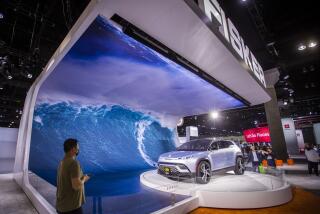Zapped by an Energy Crisis
- Share via
Puffing through the 1890s in a Stanley Steamer must have been identical to whining around town in a Solar Festiva of the 1990s.
Both cars were propelled by public concerns. Steamers addressed the rising cost of oats and street pollution. The Solar Festiva protests dirty air and a global addiction to gasoline.
Both vehicles require drivers to be patient pioneers with skins thick enough to deflect the scorn of conventional thinkers.
And whether in a car propelled by boiling water or fueled by the DWP, no journey can be taken without close attention to the consequences and limitations.
* The mind-set for driving the 120-volt Festiva built by Solar Car Corp. of Melbourne, Fla., is to imagine the car tethered by a 50-mile extension cord. That is the car’s maximum range.
* Serious hills should be avoided. Freeway ramps are manageable grades. Truckers, however, do not like following electric cars up the Grapevine.
* Travel priorities should be given to gallerias, restaurants and other buildings providing outdoor electrical outlets.
* Dress lightly for summer driving: Science has yet to develop battery-powered refrigeration.
Once those caveats have been absorbed, electric motoring is best compared to softball. The equipment, rules and techniques are similar. But the pace and excitement are far from the real thing.
On the other hand, it beats jogging. And there is a certain reward to being part of a community greening.
Solar Car Corp. has searched for an alternative to the gasoline-powered automobile for more than two years. But, founder Doug Cobb acknowledges, development continues to collide with stalemates that have plagued the electric-car industry for a century.
Batteries remain virtual antiques; heavy, quick to wear, light of load and expensive to replace. Replacing a gasoline engine with batteries actually adds 500 pounds to the weight of the car.
In cities geared to long commutes, the reduced range of electric cars restricts their roles to suburban puddle jumpers. They die on the hills of San Francisco. Speed and acceleration are dangerously beneath the entrance pace of the Los Angeles freeway system, let alone life in the frantic lanes.
Prices are high; even the environmentally dedicated are reluctant to part with $25,000 for an electric car. Especially when $10,000 will buy a Toyota that goes twice as fast with none of the inconveniences.
Cobb has put every proven energy-producing device into his solar-electric car, which is based on a Ford Festiva subcompact.
The four-cylinder engine has been replaced by an electric motor producing up to 40 horsepower. Rear seat space is filled by a battery pack containing 10 deep-cycle marine batteries.
Photovoltaic solar panels are mounted on the roof and hood. A day of full sun will replenish 15% of the car’s available power.
A regenerative system converts energy built up during the braking process into more electrical power.
Still, the car is far from viable.
That promised 50-mile range is a maximum obtained from drivers who have learned the car’s precise shift points and exact speeds for maximum mileage. Otherwise, expect 30 miles or less.
Top speed, says Solar Car press releases, “exceeds 60 m.p.h. and acceleration is impressive.”
But the maximum speed of a Solar Festiva tested was just 55 m.p.h. Acceleration from 0-50 m.p.h. was an unimpressive 22 seconds. That places the car in a drag race with street sweepers and large lads on mountain bikes.
Battery life, said Cobb, should be “between one and five years.”
Five years? By motoring short distances and maintaining 70% of available energy at all times, he said. Daily draining and recharging, Cobb admitted, will see batteries poop out in about 12 months.
Actor and activist Ed Begley owns a Solar Festiva. So does Natural Nectar Corp. of Santa Monica, manufacturers of high-fiber, low-fat FI-BAR snacks and sponsors of projects for the homeless, children, peace and the Rainbow Warrior Festival.
Externally, the car remains a Festiva by Ford, which was designed by Mazda and built in South Korea. That should be enough rainbow alliance for anyone.
Internally, there is definitely something different about the car. Atop the dash is an ammeter for measuring the strength of incoming current and a gauge to display the percentage of available energy.
Turning the key in the ignition switch sets everything humming. Depress clutch, as usual. Engage first gear, as always. Press the gas pedal and the Solar Festiva moves into traffic, as instructed. But there is no metallic gnashing from under the hood, just a whine and a whistle of 120 volts at work.
A Solar Festiva cannot be driven like a conventional car. There is no quick response to demands for more speed. A driver must set up maneuvers blocks in advance and keep senses tuned to vagaries before they develop.
It’s a delicate, peaceful game. The silence helps. So does the gentle glide. If there is any benefit to electric motoring, it may be from this solace against today’s noise and pace and not from any sense of easing environmental hurt.
There wasn’t too much time to ponder that notion.
Southbound on Pacific Coast Highway--close enough to Patrick’s Roadhouse in case things really got silent--the Solar Festiva began running out of juice at the 24-mile mark. There appeared to be no mechanical problems.
So the Festiva limped back to Santa Monica, home basement and its three-pin life-support system.
“I’m disappointed for the car not to perform as well as it has,” apologized Kate Priest, a publicist for Natural Nectar. “But the whole reason we’re into this is to support an emerging technology. The fact is, it is still emerging.”
More to Read
Sign up for Essential California
The most important California stories and recommendations in your inbox every morning.
You may occasionally receive promotional content from the Los Angeles Times.










